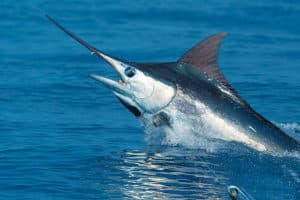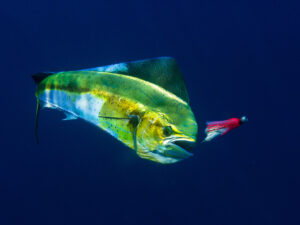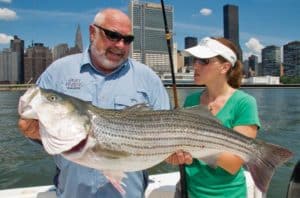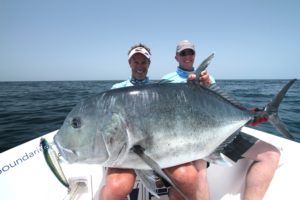In the 1930s, Bimini hosted the true pioneers of big-game fishing. Legendary anglers Zane Grey, Ernest Hemingway and Michael Lerner cut their teeth catching marlin and tuna in the Gulf Stream little more than a mile off the island’s beaches.
Anglers worldwide read of their adventurous exploits in the newspapers and magazines of the era. The mystique from those legends continues to lure fishermen to Bimini to experience the excellent fishing and the ambiance that inspired many of Hemingway’s later writings.
Bimini’s cluster of three small islands lie only 57 miles from Miami, closer to the United States mainland than any of the other Bahamas. As a fisherman’s playground, Bimini offers seasonal migrations of blue and white marlin, sailfish, wahoo, and dolphin, as well as yellowfin, blackfin and bluefins tunas. Bluewater fishing primarily excels from March through early July with the exception of an amazing wahoo run that extends from November through March.
Bonefish prowl the flats between the islands yearround. Those flats have produced numerous line- and tippet-class world records, including the all-tackle record 16 pounder, caught in 1971. Bimini also produced the only grander blue marlin ever recorded in The Bahamas.
Visitors can arrive by plane, landing at the airport on South Bimini, near a small community and a natural-limestone well. On a historic note: explorer Ponce de León once visited that well in the 1500s, hoping it to be the elusive Fountain of Youth.
While a number of carriers fly to the south island, most anglers make the quick run over on private boats or board the Bimini Fast Ferry that departs daily from Fort Lauderdale. When entering the cut between North and South Bimini, fishing boats head to the marinas at the legendary Bimini Big Game Club or the Hilton Resort World.
The main road on North Bimini—Queens Highway—starts in Alice Town. Most who come here walk or rent golf carts; the tiny size of Bimini (only 8.88 square miles) limits cars. Ferries run between the two islands and a daily tram operates on North Bimini.
Walking northward from Alice Town, visitors often stop along the way for the famous cracked conch and cold Kalik beer at Joe’s Conch Stand. Stroll farther and you pass the location of the historic Compleat Angler hotel, where Hemingway allegedly worked on one of his novels in the 1930s. The hotel burned down in 2006.
A little farther north lies the prestigious Bimini Big Game Club, the epicenter of fishing activity on the islands today. It features a full-service marina, a famous restaurant, bar, hotel, dive shop and liquor store.
The Big Game Club also hosts charter operators who target bonefish on the flats or chase marlin, wahoo, dolphin and yellowfin tuna offshore. Bottomfishermen can book trips to pull on the grouper, amberjack and snapper that prowl the reefs and shelves around the main islands and nearby smaller cays.
Great Isaac Cay to the north features a historic 150-foot lighthouse built in London in 1852 and transported to this tiny cay in 1859. The island lies abandoned, its buildings roofless from hurricanes, but an automated light still warns boats away from the rocky reefs of the Northwest Providence Channel. Expect to catch amberjacks and groupers in those very reefs and rocks.
To the south, bordering the western edge of the Great Bahama Bank, lies a chain of small islands includes Turtle and Piquet rocks, Holm, Gun, North Cat, South Cat and Ocean cays. All offer fish-attracting structure for bottomfish, midwater structure for wahoo, and a deep edge scoured by the passing Gulf Stream.
Other Bimini highlights include the Healing Hole, a pond of mineral-rich fresh water that flows up through the surrounding saltwater habitat. The Hole is fabled for its supposed healing powers, dating back hundreds of years to when the Lucayan Indians roamed these islands.
Visit the Bimini Biological Field Station and Shark Lab in Port Royal on South Bimini for tours and instructional talks on the island’s marine life.
Bimini holds a very special place in sportfishing history and is still providing anglers fresh fish tales of their own today.








